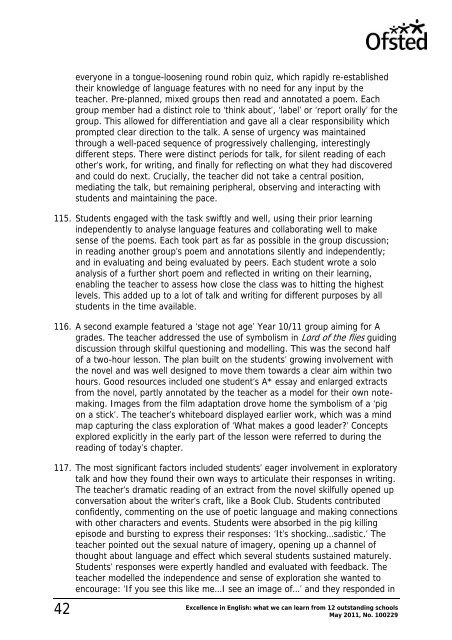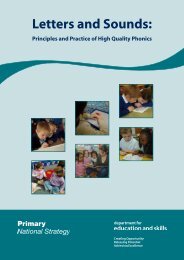Free download of:Excellence in English - Department for Education
Free download of:Excellence in English - Department for Education
Free download of:Excellence in English - Department for Education
Create successful ePaper yourself
Turn your PDF publications into a flip-book with our unique Google optimized e-Paper software.
42<br />
everyone <strong>in</strong> a tongue-loosen<strong>in</strong>g round rob<strong>in</strong> quiz, which rapidly re-established<br />
their knowledge <strong>of</strong> language features with no need <strong>for</strong> any <strong>in</strong>put by the<br />
teacher. Pre-planned, mixed groups then read and annotated a poem. Each<br />
group member had a dist<strong>in</strong>ct role to ‘th<strong>in</strong>k about’, ‘label’ or ‘report orally’ <strong>for</strong> the<br />
group. This allowed <strong>for</strong> differentiation and gave all a clear responsibility which<br />
prompted clear direction to the talk. A sense <strong>of</strong> urgency was ma<strong>in</strong>ta<strong>in</strong>ed<br />
through a well-paced sequence <strong>of</strong> progressively challeng<strong>in</strong>g, <strong>in</strong>terest<strong>in</strong>gly<br />
different steps. There were dist<strong>in</strong>ct periods <strong>for</strong> talk, <strong>for</strong> silent read<strong>in</strong>g <strong>of</strong> each<br />
other’s work, <strong>for</strong> writ<strong>in</strong>g, and f<strong>in</strong>ally <strong>for</strong> reflect<strong>in</strong>g on what they had discovered<br />
and could do next. Crucially, the teacher did not take a central position,<br />
mediat<strong>in</strong>g the talk, but rema<strong>in</strong><strong>in</strong>g peripheral, observ<strong>in</strong>g and <strong>in</strong>teract<strong>in</strong>g with<br />
students and ma<strong>in</strong>ta<strong>in</strong><strong>in</strong>g the pace.<br />
115. Students engaged with the task swiftly and well, us<strong>in</strong>g their prior learn<strong>in</strong>g<br />
<strong>in</strong>dependently to analyse language features and collaborat<strong>in</strong>g well to make<br />
sense <strong>of</strong> the poems. Each took part as far as possible <strong>in</strong> the group discussion;<br />
<strong>in</strong> read<strong>in</strong>g another group’s poem and annotations silently and <strong>in</strong>dependently;<br />
and <strong>in</strong> evaluat<strong>in</strong>g and be<strong>in</strong>g evaluated by peers. Each student wrote a solo<br />
analysis <strong>of</strong> a further short poem and reflected <strong>in</strong> writ<strong>in</strong>g on their learn<strong>in</strong>g,<br />
enabl<strong>in</strong>g the teacher to assess how close the class was to hitt<strong>in</strong>g the highest<br />
levels. This added up to a lot <strong>of</strong> talk and writ<strong>in</strong>g <strong>for</strong> different purposes by all<br />
students <strong>in</strong> the time available.<br />
116. A second example featured a ‘stage not age’ Year 10/11 group aim<strong>in</strong>g <strong>for</strong> A<br />
grades. The teacher addressed the use <strong>of</strong> symbolism <strong>in</strong> Lord <strong>of</strong> the flies guid<strong>in</strong>g<br />
discussion through skilful question<strong>in</strong>g and modell<strong>in</strong>g. This was the second half<br />
<strong>of</strong> a two-hour lesson. The plan built on the students’ grow<strong>in</strong>g <strong>in</strong>volvement with<br />
the novel and was well designed to move them towards a clear aim with<strong>in</strong> two<br />
hours. Good resources <strong>in</strong>cluded one student’s A* essay and enlarged extracts<br />
from the novel, partly annotated by the teacher as a model <strong>for</strong> their own notemak<strong>in</strong>g.<br />
Images from the film adaptation drove home the symbolism <strong>of</strong> a ‘pig<br />
on a stick’. The teacher’s whiteboard displayed earlier work, which was a m<strong>in</strong>d<br />
map captur<strong>in</strong>g the class exploration <strong>of</strong> ‘What makes a good leader?’ Concepts<br />
explored explicitly <strong>in</strong> the early part <strong>of</strong> the lesson were referred to dur<strong>in</strong>g the<br />
read<strong>in</strong>g <strong>of</strong> today’s chapter.<br />
117. The most significant factors <strong>in</strong>cluded students’ eager <strong>in</strong>volvement <strong>in</strong> exploratory<br />
talk and how they found their own ways to articulate their responses <strong>in</strong> writ<strong>in</strong>g.<br />
The teacher’s dramatic read<strong>in</strong>g <strong>of</strong> an extract from the novel skilfully opened up<br />
conversation about the writer’s craft, like a Book Club. Students contributed<br />
confidently, comment<strong>in</strong>g on the use <strong>of</strong> poetic language and mak<strong>in</strong>g connections<br />
with other characters and events. Students were absorbed <strong>in</strong> the pig kill<strong>in</strong>g<br />
episode and burst<strong>in</strong>g to express their responses: ‘It’s shock<strong>in</strong>g…sadistic.’ The<br />
teacher po<strong>in</strong>ted out the sexual nature <strong>of</strong> imagery, open<strong>in</strong>g up a channel <strong>of</strong><br />
thought about language and effect which several students susta<strong>in</strong>ed maturely.<br />
Students’ responses were expertly handled and evaluated with feedback. The<br />
teacher modelled the <strong>in</strong>dependence and sense <strong>of</strong> exploration she wanted to<br />
encourage: ‘If you see this like me…I see an image <strong>of</strong>…’ and they responded <strong>in</strong><br />
<strong>Excellence</strong> <strong>in</strong> <strong>English</strong>: what we can learn from 12 outstand<strong>in</strong>g schools<br />
May 2011, No. 100229
















